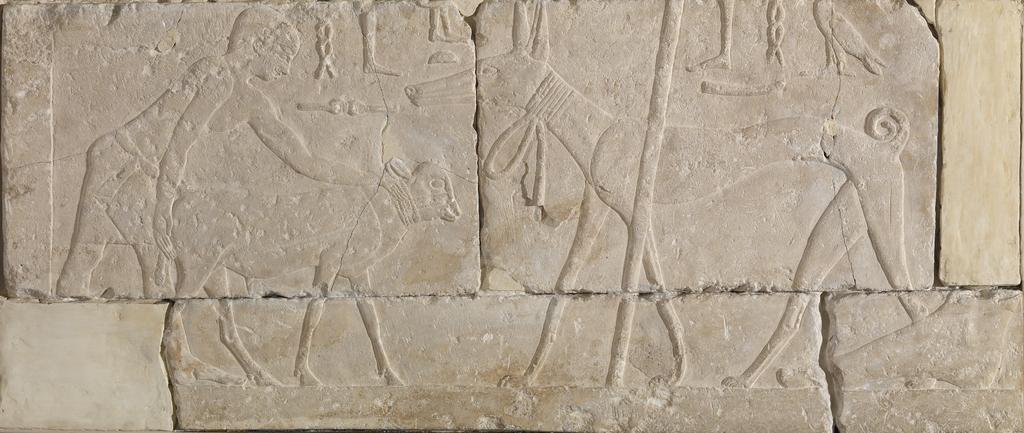MAKE A MEME
View Large Image

| View Original: | Egyptian - Man with Calf and Dog - Walters 22422.jpg (1798x761) | |||
| Download: | Original | Medium | Small | Thumb |
| Courtesy of: | commons.wikimedia.org | More Like This | ||
| Keywords: Egyptian - Man with Calf and Dog - Walters 22422.jpg This Old Kingdom relief fragment has suffered severe damage from salt since its original carving This has caused pitting over many areas of the piece especially on the foot of the man the calf and the dog The preserved carving is in fine raised relief including such small details as the hair at the tip of the calf's tail and the 'elbow' on each of the dog's legs The block was originally painted and traces of red pigment still remains in some areas There are two separate scenes actually depicted easily distinguished by the different scales of the figures On the left is a man at small scale who bends over a calf pushing at the rear with one hand while pulling on the rope tied around it's neck with the other A single man doing this is uncommon and the sharp angle at which the servant bends in order to simultaneously lead and push the calf from behind is also unusual The man has short hair and wears a short fitted shendyt with a large tie at the waist This type of shendyt is first seen in the 4th Dynasty but continues into the 6th Dynasty The musculature of the man's biceps is paralleled in tombs of both the 4th and 5th Dynasty such as the tomb of Nofer at Giza and that of Sekhem-ankh-ptah at Saqqara Above the calf is an inscription which reads Bringing the calf jn t bhz Facing the man and calf is a dog identifiable by his long narrow muzzle nearly straight facial profile slender body long neck and limbs Brewer 116 as a greyhound with a rope collar and curled tail The dog stands at his master's feet to whose scale he is carved The tomb owner's staff crosses the body of the dog as does his left foot Above the dog is his name Beha bh3 possibly an abbreviation of behkai oryx antelope a dog's name known from other contexts Beginning in the 5th Dynasty dogs are commonly placed in hunting scenes in the fields or under the deceased's chair However a very similar scene to this one in which the tomb owner stands with his dog at his feet can be found at Giza in the tomb of Ha-ef-Ra-ankh from the middle or late 5th Dynasty The type of the dog as well as his collar are so similar that it is likely that the relief comes from this tomb or was made by the same craftsmen team in a tomb nearby The dual composition of the relief fragment suggests it is part of a larger wall scene in which various servants of the tomb owner's estate bring and present the products and wealth of his holdings to him During the Old Kingdom these types of scenes were generally placed on the east and west walls of a tomb The thick border which forms the left edge and base of the scene might imply that it was located either next to a door or as part of a long wall with multiple false doors and/or multiple scenes The tomb from which the fragment originated must be located at Giza and dates to the middle or late 5th Dynasty based on relief and composition ca 2400 BC Old Kingdom carved limestone red pigment cm 43 101 3 5 accession number 22 422 22038 Paris 1914 First time reported by the Egyptologist Raymond Weill who saw the relief in Paris in 1914 Joseph Brummer New York and Paris date and mode of acquisition unknown Parke-Bernet Galleries New York 1949 101 lot 474 Walters Art Museum 1949 by purchase Museum purchase 1949 Transcription Inscription above the dog bh3; Translation Inscription above the dog Beha name of dog; Transcription Inscription above the calf jn t bhz; Translation Inscription above the calf Bring the calf To Arrest the Ravages of Time Caring for Art at the Walters The Walters Art Gallery Baltimore 1996 In Search of Ancient Treasure 40 Years of Collecting The Walters Art Gallery Baltimore 1978 place of origin Giza Egypt Walters Art Museum license Ancient Egyptian reliefs in the Walters Art Museum Mammals in Ancient Egypt Ancient Egyptian art from Giza necropolis | ||||